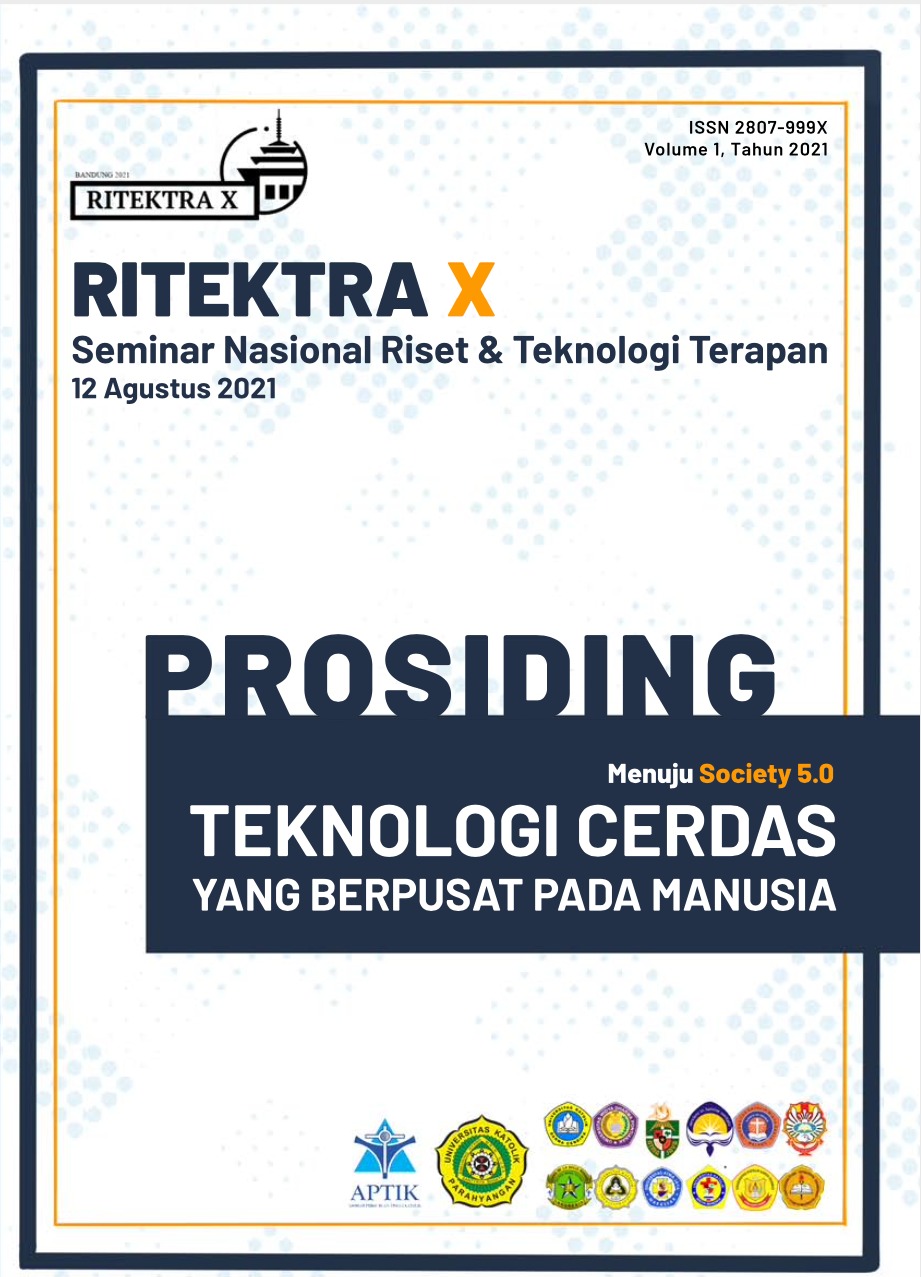PENGARUH KANDUNGAN SELULOSA DAN LIGNIN PADA PULP KULIT PISANG KEPOK DALAM PEMBUATAN KERTAS SENI
Kata Kunci:
kertas, selulosa, kulit pisangAbstrak
Kulit pisang merupakan limbah biomassa yang belum banyak dimanfaatkan. Kulit pisang mengandung selulosa yang dapat digunakan dalam pembuatan kertas seni. Pada penelitian ini, pembuatan kertas dilakukan dengan metode alkalisasi menggunakan larutan NaOH (4, 6, dan 8%-b). Rasio kulit pisang terhadap larutan NaOH dijaga pada 1:8 b/v. Proses pemasakan dilakukan pada 100 oC dan 1,5 jam. Analisa yang dilakukan adalah analisa kandungan pulp (selulosa dan lignin) serta analisa kualitas produk kertas (gramatur dan indeks tarik). Penambahan sizing agent berupa CMC (Carboxymethyl cellulose) sebanyak 5%-b dilakukan pada formulasi terbaik untuk meningkatkan kekuatan tarik pada kertas. Hasil penelitian menunjukkan bahwa.konsentrasi NaOH 6%-b memberikan kekuatan tarik terbaik sebesar 6,16 Nm/g dan gramatur sebesar 158 g/m2. Penambahan CMC dapat meningkatkan kekuatan tarik menjadi menambah kekuatan tarik kertas menjadi 7,735 Nm/g.
Referensi
Allita, Y., Gala, V., Citra, A. A., & Retnoningtyas, E. S. (2018). Pemanfaatan ampas tebu dan kulit pisang dalam pembuatan kertas serat campuran. Jurnal Teknik Kimia Indonesia, 11(2), 101. https://doi.org/10.5614/jtki.2012.11.2.6
Azeez, M. A. (2018). Pulping of Non-Woody Biomass. In Pulp and Paper Processing. InTech. https://doi.org/10.5772/intechopen.79749
Beghello, L., Long, L., & Eklund, D. (1997). Laboratory study on carboxymethylcellulose as a wet-end additive in paperboard making. Pap.Puu., 79(1), 55–57.
BPS. (2018). Produksi Buah-Buahan Menurut Kabupaten/Kota di Provinsi Jawa Barat.
BSNI. (2008). Pulp - Cara uji kadar selulosa alfa, beta, dan gamma.
Germgård, U., Hartler, N., & Mjöberg, P. J. (1980). Contributions from pulp components to paper brittleness. Cellulose Chemical Technology, 14(4), 549–556.
Hagiopol, C., & Johnston, J. W. (2011). Chemistry of Modern Papermaking. CRC Press. https://doi.org/10.1201/b11011
Hubbe, M. (2006). Bonding between cellulosic fibers in the absence and presence of dry-strength agents - A review. BioResources, 1(2), 281–318.
Humphreys, P. N., Laws, A., & Dawson, J. (2010). A Review of Cellulose Degradation and the Fate of Degradation Products Under Repository Conditions.
Kaul, R. H., & Ibrahim, V. (2013). Lignin-degrading enzymes: an overview. In Bioprocessing Technologies in Biorefinery for Sustainable Production of Fuels, Chemicals and Polymers. John Wiley & Sons.
Laine, J., Lindström, T., Nordmark, G., & Risinger, G. (2002). Studies on topochemical modification of cellulosic fibres. Part 2. The effect of carboxymethyl cellulose attachment on fibre swelling and paper strength. Nord. Pulp Pap. Res. J., 17(1), 50–56.
Lebo, S. E., Gargulak, J. D., & McNally, T. J. (2001). Lignin. In Kirk-Othmer Encyclopedia of Chemical Technology. John Wiley and Sons.
Molin, U., & Teder, A. (2002). Importance of cellulose/hemicellulose-ratio for pulp strength. Nordic Pulp & Paper Research Journal, 17(1), 14-19a. https://doi.org/10.3183/npprj-2002-17-01-p014-019
Norman, A. G., & Jenkins, S. H. (1933). Lignin Content of Cellulose Products. Nature, 131(3316), 729–729. https://doi.org/10.1038/131729a0
Novianti, P., & Eko Setyowati, W. A. (2016). Pemanfaatan Limbah Kulit Pisang Kepok sebagai Bahan Baku Pembuatan Kertas Alami dengan Metode Pemisahan Alkalisasi. In Seminar Nasional Pendidikan Sains VI 2016.
Pelissari, F. M., Sobral, P. J. do A., & Menegalli, F. C. (2014). Isolation and characterization of cellulose nanofibers from banana peels. Cellulose, 21(1), 417–432. https://doi.org/10.1007/s10570-013-0138-6
Sluiter, A., Hames, B., Ruiz, R., Scarlata, C., Sluiter, J., Templeton, D., & Crocker, D. (2008). Determination of Structural Carbohydrates and Lignin in Biomass.
Statista. (2021). Paper consumption worldwide from 2020 to 2030. https://statista.com
Wisur, H., Sjöberg, L. A., & Ahlgren, P. (1993). Selecting a potential Swedish fibre crop: Fibres and fines in different crops as an indication of their usefulness in pulp and paper production. Industrial Crops and Products, 2(1), 39–45.
##submission.downloads##
Diterbitkan
Terbitan
Bagian
Lisensi
Hak Cipta (c) 2021 Putri Ramadhany, Tony Handoko

Artikel ini berlisensi Creative Commons Attribution 4.0 International License.

